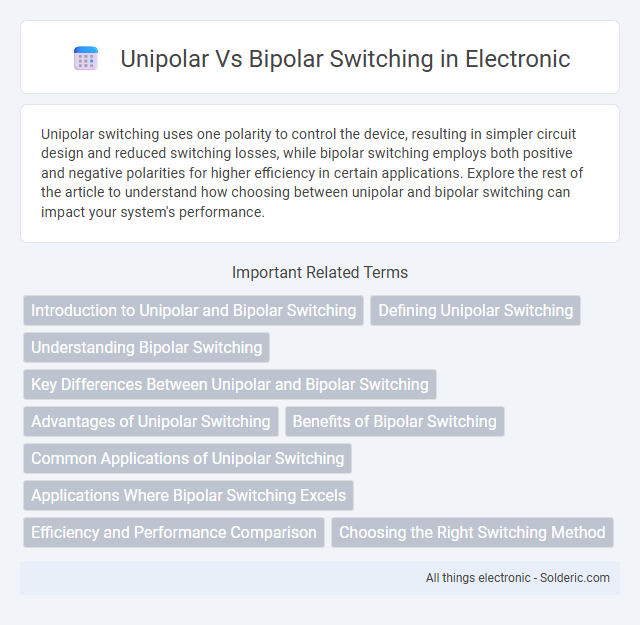Unipolar switching uses one polarity to control the device, resulting in simpler circuit design and reduced switching losses, while bipolar switching employs both positive and negative polarities for higher efficiency in certain applications. Explore the rest of the article to understand how choosing between unipolar and bipolar switching can impact your system's performance.
Comparison Table
| Feature | Unipolar Switching | Bipolar Switching |
|---|---|---|
| Definition | Switching current flow in one direction only | Switching current flow alternates direction |
| Current Flow | Single polarity | Dual polarity (positive and negative) |
| Switching Device | Uses unipolar transistors (MOSFETs) | Uses bipolar transistors (BJTs, IGBTs) |
| Complexity | Lower circuit complexity | Higher circuit complexity |
| Efficiency | Lower switching losses | Higher switching losses |
| Applications | Low power converters, simple motor drives | High power drives, inverters, AC motor control |
| Control Method | Simple PWM control | Complex modulation required |
| Power Handling | Typically low to medium power | Medium to high power applications |
Introduction to Unipolar and Bipolar Switching
Unipolar switching involves current flow in a single direction through the device, commonly used in MOSFET-based circuits for efficient switching with lower power loss. Bipolar switching allows current to flow in both directions, characteristic of BJTs, enabling higher current handling and better performance in high-power applications. Understanding these switching mechanisms is essential for optimizing transistor selection in power electronics and signal processing.
Defining Unipolar Switching
Unipolar switching refers to a transistor switching mechanism where current flows in only one direction through the device, commonly used in power electronics to control power delivery efficiently. In unipolar switching, the device operates by modulating a single type of charge carrier, either electrons or holes, minimizing conduction losses and improving switching speed. This contrasts with bipolar switching, which involves both types of charge carriers, typically resulting in higher complexity and potentially greater power dissipation.
Understanding Bipolar Switching
Bipolar switching involves the use of both positive and negative voltage polarities to control device states, enabling more precise modulation compared to unipolar switching. This method is critical in ferroelectric random-access memory (FeRAM) technologies, where polarization reversal under opposite electric fields determines data storage reliability. The bipolar approach enhances endurance and reduces fatigue in materials by alternating the electric field direction, improving long-term device performance.
Key Differences Between Unipolar and Bipolar Switching
Unipolar switching involves current flow in only one direction, making it simpler and reducing switching losses, while bipolar switching requires alternating current direction, enabling higher voltage and power output. Unipolar devices typically use two switching states, whereas bipolar devices rely on three states, affecting the complexity and control strategies in power electronics. Your choice between unipolar and bipolar switching impacts efficiency, thermal management, and overall system performance depending on the application requirements.
Advantages of Unipolar Switching
Unipolar switching offers faster switching speeds and reduced power dissipation compared to bipolar switching, enhancing overall device efficiency. It simplifies circuit design by using a single type of charge carrier, which reduces switching losses and improves thermal performance. Your electronic systems benefit from improved reliability and lower electromagnetic interference when implementing unipolar switching technology.
Benefits of Bipolar Switching
Bipolar switching offers enhanced control over device operation by utilizing both positive and negative polarities, resulting in reduced power consumption and improved efficiency compared to unipolar switching. This method enables faster switching speeds and better thermal management, which extends device lifespan and reliability. Your electronic applications benefit from bipolar switching through higher performance and greater precision in signal modulation.
Common Applications of Unipolar Switching
Unipolar switching is widely used in stepper motors for precise control in applications such as 3D printers, CNC machines, and robotics, where directional accuracy and smooth motion are crucial. This type of switching simplifies the driver circuitry by energizing coils in one direction, leading to reduced complexity and cost. Its effectiveness in low to moderate torque scenarios makes unipolar switching ideal for consumer electronics and small automation systems.
Applications Where Bipolar Switching Excels
Bipolar switching excels in applications requiring precise control of current direction, such as in H-bridge motor drivers for reversible DC motor operation. It is widely used in analog signal modulation and power electronics where efficient bidirectional current flow enhances performance. Your choice of bipolar switching ensures superior performance in complex circuits demanding symmetrical switching capabilities.
Efficiency and Performance Comparison
Unipolar switching offers higher efficiency for low-power applications due to simpler drive requirements and reduced switching losses, while bipolar switching provides superior performance in high-frequency operations with better current control and faster switching speeds. You can expect unipolar devices to consume less power in moderate loads, whereas bipolar devices excel in high-power, high-speed environments. Choosing the right switching type depends on balancing your efficiency needs against performance demands for specific applications.
Choosing the Right Switching Method
Choosing the right switching method depends on your application's specific requirements, such as power efficiency, heat dissipation, and switching speed. Unipolar switching offers lower power loss and simpler circuit design by using a single polarity current, making it ideal for applications needing lower noise and less electromagnetic interference. Bipolar switching provides greater torque and faster response in motor controls but involves more complex circuitry and increased power consumption.
Unipolar vs Bipolar Switching Infographic

 solderic.com
solderic.com